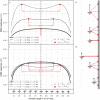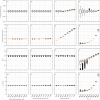Spatial Encoding of Translational Optic Flow in Planar Scenes by Elementary Motion Detector Arrays
- PMID: 29643402
- PMCID: PMC5895815
- DOI: 10.1038/s41598-018-24162-z
Spatial Encoding of Translational Optic Flow in Planar Scenes by Elementary Motion Detector Arrays
Abstract
Elementary Motion Detectors (EMD) are well-established models of visual motion estimation in insects. The response of EMDs are tuned to specific temporal and spatial frequencies of the input stimuli, which matches the behavioural response of insects to wide-field image rotation, called the optomotor response. However, other behaviours, such as speed and position control, cannot be fully accounted for by EMDs because these behaviours are largely unaffected by image properties and appear to be controlled by the ratio between the flight speed and the distance to an object, defined here as relative nearness. We present a method that resolves this inconsistency by extracting an unambiguous estimate of relative nearness from the output of an EMD array. Our method is suitable for estimation of relative nearness in planar scenes such as when flying above the ground or beside large flat objects. We demonstrate closed loop control of the lateral position and forward velocity of a simulated agent flying in a corridor. This finding may explain how insects can measure relative nearness and control their flight despite the frequency tuning of EMDs. Our method also provides engineers with a relative nearness estimation technique that benefits from the low computational cost of EMDs.
Conflict of interest statement
The authors declare no competing interests.
Figures







Similar articles
-
Local motion adaptation enhances the representation of spatial structure at EMD arrays.PLoS Comput Biol. 2017 Dec 27;13(12):e1005919. doi: 10.1371/journal.pcbi.1005919. eCollection 2017 Dec. PLoS Comput Biol. 2017. PMID: 29281631 Free PMC article.
-
Neuronal matched filters for optic flow processing in flying insects.Int Rev Neurobiol. 2000;44:93-120. doi: 10.1016/s0074-7742(08)60739-4. Int Rev Neurobiol. 2000. PMID: 10605643 Review. No abstract available.
-
Optic flow-based collision-free strategies: From insects to robots.Arthropod Struct Dev. 2017 Sep;46(5):703-717. doi: 10.1016/j.asd.2017.06.003. Epub 2017 Jul 11. Arthropod Struct Dev. 2017. PMID: 28655645 Review.
-
Optic flow based spatial vision in insects.J Comp Physiol A Neuroethol Sens Neural Behav Physiol. 2023 Jul;209(4):541-561. doi: 10.1007/s00359-022-01610-w. Epub 2023 Jan 7. J Comp Physiol A Neuroethol Sens Neural Behav Physiol. 2023. PMID: 36609568 Free PMC article. Review.
-
Pattern-dependent response modulations in motion-sensitive visual interneurons--a model study.PLoS One. 2011;6(7):e21488. doi: 10.1371/journal.pone.0021488. Epub 2011 Jul 8. PLoS One. 2011. PMID: 21760894 Free PMC article.
Cited by
-
Stabilizing responses to sideslip disturbances in Drosophila melanogaster are modulated by the density of moving elements on the ground.Biol Lett. 2021 Mar;17(3):20200748. doi: 10.1098/rsbl.2020.0748. Epub 2021 Mar 3. Biol Lett. 2021. PMID: 33653094 Free PMC article.
-
The role of optic flow pooling in insect flight control in cluttered environments.Sci Rep. 2019 May 22;9(1):7707. doi: 10.1038/s41598-019-44187-2. Sci Rep. 2019. PMID: 31118454 Free PMC article.
-
Resource-efficient bio-inspired visual processing on the hexapod walking robot HECTOR.PLoS One. 2020 Apr 1;15(4):e0230620. doi: 10.1371/journal.pone.0230620. eCollection 2020. PLoS One. 2020. PMID: 32236111 Free PMC article.
-
Contrast independent biologically inspired translational optic flow estimation.Biol Cybern. 2022 Dec;116(5-6):635-660. doi: 10.1007/s00422-022-00948-3. Epub 2022 Oct 27. Biol Cybern. 2022. PMID: 36303043 Free PMC article.
-
A Hardware-Friendly Optical Flow-Based Time-to-Collision Estimation Algorithm.Sensors (Basel). 2019 Feb 16;19(4):807. doi: 10.3390/s19040807. Sensors (Basel). 2019. PMID: 30781489 Free PMC article.
References
-
- Gibson JJ. The perception of the visual world. Psychological Bulletin. 1950;48:1–259.
Publication types
MeSH terms
LinkOut - more resources
Full Text Sources
Other Literature Sources
Molecular Biology Databases

